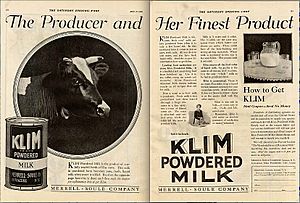Klim (powdered milk) facts for kids
Klim (which you can also see written as KLIM) is a popular brand of powdered milk. It's sold all over the world by a company called Nestlé. Nestlé bought the Klim brand in 1998 from another company named Borden. A fun fact about Klim is that early advertisements used the slogan "Spell it backwards." (Hint: it's "milk"!)
Contents
The Story of Klim Milk Powder
Klim was first created as a special kind of powdered milk that could be used in hot, tropical places. Regular milk spoils very quickly in such heat, but Klim was designed to last a long time.
Klim's Early Days
Because it was lightweight and didn't spoil, Klim became a favorite for people exploring jungles, scientists, soldiers, and anyone who needed food that would stay fresh for days, even in hot and humid weather.
In 1920, Klim was made by the Merrell-Soule Company in Syracuse, New York. This company had found a better way to make powdered milk. They started with condensed milk instead of regular milk, which made the process work even better.
Borden Buys Klim
In 1927, a big company called Borden bought Merrell-Soule. This meant Borden now owned the popular Klim brand, along with another product called None Such Mincemeat. Both of these products were already well-known around the world.
Klim During World War II
During World War II, Klim was very important for soldiers. The U.S. Army used it as part of their "Jungle ration." One officer said that the powdered milk stayed safe for years in its strong can. Even after opening, it could last for about a week in the jungle heat if kept in a waterproof bag.
Later, the Red Cross gave Klim to prisoners of war, especially those held in German camps. This helped the prisoners get more calories and stay healthier.
Klim in Shanghai
A famous British author named J. G. Ballard wrote about Klim in his books. He said that after the Japanese surrendered in August 1945, American relief supplies were dropped over Shanghai, China. These supplies included cans of powdered Klim milk. Ballard, who was a teenager at the time, had been held in a prison camp for over two years. He mentioned Klim cans, along with other items like SPAM and chocolate, in his novel Empire of the Sun and his autobiography Miracles of Life.
Klim was also found in other war zones, like the Burma Campaign. Troops who were retreating from the Japanese invasion found tins of Klim in empty villages. These cans were very helpful and gave the soldiers much-needed food.
Klim Cans and Escapes
Klim cans were about four inches wide and three inches deep. The metal from these cans was very useful! Prisoners of war could turn them into all sorts of tools and helpful items, like scoops or candle holders.
The Great Escape and Klim Cans
Klim cans played a big part in a famous escape attempt from a prison camp called Stalag Luft III. In the book Under The Wire, William Ash and Brendan Foley explain how prisoners removed the bottoms from the Klim tins. They then hooked these pieces together to make airtight pipes. These pipes were used to provide air while the prisoners dug escape tunnels.
The scavenged Klim cans were used to build a large ventilation system for three tunnels leading out of the prison camp. One former prisoner, Charles Huppert, shared how good the prisoners became at turning tin cans into tools. He said they used Klim tins for everything they made because they could cut out the ends to get a large piece of tin. They could flatten it out and join pieces together to make strong tools for digging, funnels, and even lamps to light the tunnels.


